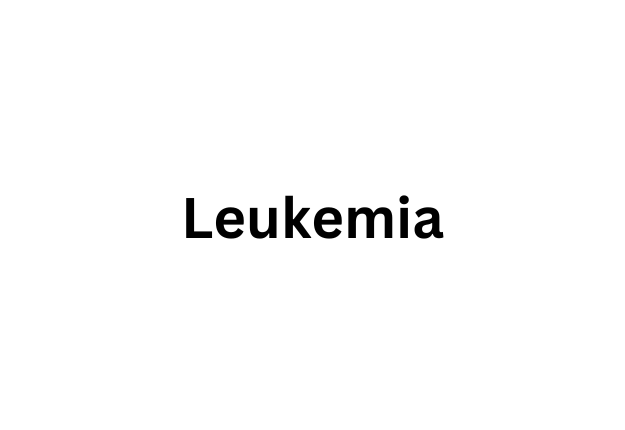Leukemia is a form of cancer with an annual diagnosis rate of 14.1 people per 100,000 of the population, with nearly half of these cases (6.0 per 100,000) dying from the disease. People over 55 and under 15 are the population group in which this condition is most common.1
Leukemia is a systemic malignant (cancerous) lesion of the red bone marrow during which healthy leukocytes (white blood cells involved in immunity) are replaced by altered cells.
Abnormal leukocytes do not perform their proper functions but continue to divide. This division increases the number of abnormal cells.
These abnormal cells move with the blood to penetrate body organs, causing pathological like differentiating (changing their cells) into cancer.2
Correlations to leukemia
The etiology, or causes of leukemia, are unknown. Certain risk factors for developing leukemia include:
- Down syndrome,
- exposure to chemical carcinogens like benzene,
- chemotherapy from other cancer treatments,
- ionizing radiation
- radiation therapy for other tumors, workplace exposure, or ultraviolet radiation,
- viruses such as the human T-lymphotropic virus (HTLV) and human immunodeficiency virus (HIV),
- tobacco use,
- certain hair dyes,
- and hereditary predisposition.3
Signs and symptoms of leukemia
The signs and symptoms of leukemia vary based on the person’s health, age, and type of leukemia.
In acute leukemia, symptoms quickly appear and intensify. Body temperature rises rapidly, and health deterioration occurs in a short period.
In chronic leukemia, the symptoms increase slowly, and the progression can be lengthy. The expressed signs of chronic leukemia appear when the developed and terminal stage of the disease sets in.
With advanced leukemia, hemorrhage (bleeding) is a major concern. A slight injury can cause an extensive internal hemorrhage, complications can arise, and the patient may die if untreated.2,4
The primary signs and symptoms of acute and chronic leukemia are
- a high body temperature for no apparent reason,
- increased night sweats,
- fatigue,
- poor appetite,
- nausea,
- weight loss within a short period and for no apparent reason,
- poor blood clotting,
- problems with coordination,
- shortness of breath without intense exertion,
- formation of hematomas (extensive bruising in places of minor injuries),
- pain in the joints and bones,
- headaches,
- frequent bleeding from the nose and gums,
- and an increased incidence of infections.2
Diagnosis of leukemia
Diagnosis of leukemia involves examining the patient, identifying complaints and objective clinical manifestations of the disease, and several medical tests. Diagnostic tests for leukemia may include:
- a general blood test to detect an increase in the number of leukocytes and a decrease in the number of other types of blood cells,
- an immunogram (an image of the immune system) showing dysfunction of the immune system,
- a cytogenetic analysis that detects changes in chromosomes,
- a computed tomography (CT scan) and magnetic resonance imaging (MRI) to obtain detailed photos of the affected organ from different angles,
- punctures of the bone, spinal cord, and lymph nodes to extract cells for analysis to determine the type of cellular damage, the level of sensitivity to chemicals, and to identify other leukemia-related data,
- and reverse transcription–polymerase chain reaction test (RT–PCR) that allows identifying the activation of certain genes associated with cancer..2, 5
Treatment of leukemia
The outcomes of leukemia treatment depend on many factors. Some of these factors include:
- the form and nature of the course of the disease,
- the timing of detection,
- the degree of damage to internal organs,
- and the general condition of the body.
In general, cancer responds well to modern treatments like chemotherapy, radiation, targeted therapy, and chemotherapy with stem cell transplants.
Chemotherapy
Chemotherapy is administering a combination of drugs that slow or stop tumor growth in cancer patients. Unfortunately, this therapy has many severe adverse effects as it also damages healthy cells.
Because tumor cells divide faster than the surrounding healthy cells, chemotherapy mostly affects cancerous cells.
Radiation therapy
Radiation therapy for cancer uses electromagnetic radiation energy or beams of elementary nuclear particles. The radiation energy and nuclear particles kill tumor cells or restrain their growth and division.
Targeted therapy
Targeted therapy is based on the selective intervention of intracellular mechanisms necessary for tumor growth. Unlike traditional chemotherapy, targeted therapy blocks the signaling pathways telling cells they must divide.
Chemotherapy with stem cell transplant
Chemotherapy with stem cell transplant is when a patient is given a high dose of chemotherapy that kills cancerous and healthy blood-forming cells.
After the killing of cells, the patient undergoes transplantation with stem cells (immature blood cells). These stem cells develop into healthy cells that perform the functions of the removed bone marrow.2, 5
Leukemia patients have hope
With the timely start of treatment, leukemia patients can have favorable outcomes. In many cases, treatments help to achieve long-term remission with 65.7% of patients surviving for five years or more after diagnosis.1
References
- Leukemia – Cancer Stat Facts. National Cancer Institute Surveillance, Epidemiology, and End Results Program. https://seer.cancer.gov/statfacts/html/leuks.html. Accessed March 26, 2023.
- Adult Acute Lymphoblastic Leukemia Treatment (PDQ®)–health professional version. National Cancer Institute. https://www.cancer.gov/types/leukemia/hp/adult-all-treatment-pdq. Published February 24, 2023. Accessed March 23, 2023.
- What causes leukemia. Moffitt Cancer Center. https://moffitt.org/cancers/leukemia/diagnosis/causes/. Published 2023. Accessed March 26, 2023.
- Pemmaraju N. Common leukemia symptoms: What to look for. MD Anderson Cancer Center. https://www.mdanderson.org/cancerwise/common-leukemia-symptoms–what-to-look-for.h00-159462423.html. Published July 15, 2021. Accessed March 26, 2023.
- Acute myeloid leukemia treatment (PDQ®)–patient version. National Cancer Institute. https://www.cancer.gov/types/leukemia/patient/adult-aml-treatment-pdq. Published August 19, 2019. Accessed March 26, 2023.



